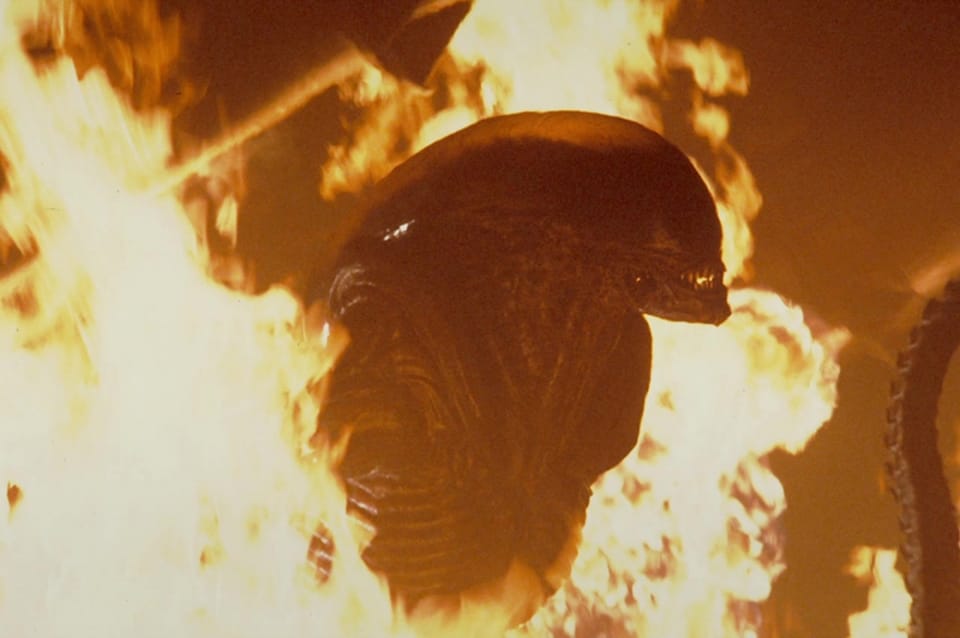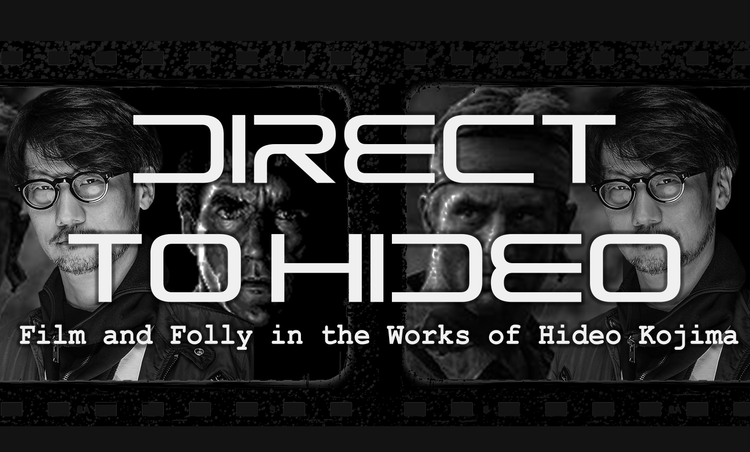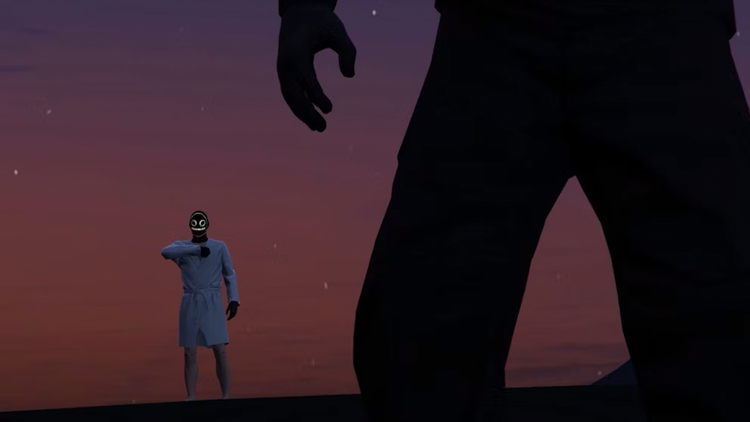Alien³: Scar Beast

Prologue I'll Never Be Top of the Line Again
The original Alien is immaculate, and its sequel's only sin is that it's not Alien. From this position (which I agree with, Alien is one of my favorite films) consensus has generally regarded Alien³ as The Fall, a paradise lost. Ever since its 1992 premiere fans have been clamoring, if not for an outright retcon of its plot then at least a return to form for the series, something to take it back to the prelapserian perfection of the first two movies.
I have to confess I have never been one of them. Even in its heavily compromised theatrical cut the movie is too fascinatingly strange to dismiss, so ragged and insistently morbid. Uninspired studio films by committee are the rule rather than the exception, great movies by respected auteurs rare jewels, and recklessly bad passion projects trashy treasures. We know these kinds of movies, we have a framework for them. Alien³ is neither hack work nor inspiration but a bitter custody battle. Pulled in so many directions it should have been like its cast, torn apart. Yet it comes together often enough, and in such striking ways, that even its failures inspire fascination. It is my favorite broken film.
1 At Fox, No One Can Hear You Scream
There are many ways that 20th Century Fox could have followed up Aliens, and they considered all of them. Or at least half a dozen. The first of these, penned by Neuromancer author William Gibson, is easily the most famous, a Cold War satire that saw original trilogy protagonist Ripley (Sigourney Weaver) remaining cryo-frozen and Newt, Hicks, and Bishop (Lance Henrikson) caught up in a conflict between a socialist union and a space station shopping mall. The Gibson script has been oddly successful for a movie that never was, having since 2018 been adapted into a comic, an audio book, and a novel. Had it been produced it likely would have been more liked than the third Alien film that was actually made, most anything would have, but it has its own share of franchise heresies—sidelining Ripley, mucking with the biology of the xenomorph such that it reproduces through a virus—that would have angered fans. And really, any follow-up was going to have to live up to its unimprovable predecessors without repeating them, the latter a directive from series stewards and Brandywine Productions heads David Giler and Walter Hill, who were not interested in an easy cash-in.
And so the producers spent years cycling through pitches and scripts, a process that continued even after greenlighting. After multiple vetoes that included a pair of back-to-back productions set on Earth and then the alien home world pitched by Nightmare on Elm Stree 4 director Renny Harlin, construction began on sets from a script by John Fasano based on a concept by Vincent Ward (The Navigator: A Medieval Odyssey), who would direct. But Giler and Hill had too many questions about the setting—a planet made of wood run by luddite monks—and so it was rewritten by Giler and Hill, who hired Larry Ferguson as a script doctor, whose work was revised still further by Giler and Hill. During this time a 27-year-old music video and commercial director named David Fincher was hired, and he in turn hired his own script doctor, future Sideways author Rex Pickett, behind the producers' backs.
The story that emerged from this torturous process, now titled Alien³, pulled from nearly all of the rejected concepts and treatments: a previous script by Eric Red (The Hitcher) killed off the entire old cast and had the aliens using animals as hosts, the prison planet setting was retained from a script by future Pitch Black director David Twohy, and the basic contours of its religious-themed story is retained from the Ward version. By now Sigourney Weaver had signed on as a producer but stipulated that Ripley had to die as there would be nothing left to do with the character. Conspicuously absent from the final concept was planet Earth, which didn't stop Fox from cutting a teaser in January 1991 that promised "On Earth, everyone can hear you scream" and committing the movie to a release the following year.
It was the first of the production's many, many troubles. Already using sets built for the discarded Vincent Ward, Fincher had to shoot on a reduced schedule, with fewer effects shots. New pages came in daily, and Fincher had fights with Fox brass just as often. His legendary perfectionism arrived fully-formed on this, his first film, obsessing over the look of blood and spending hours getting the right take for shots containing steam and chains and any number of visual elements. All of which had little truck with a studio that just wanted to get the damn thing out the door.
Fincher was fired three times, and ultimately he did not have final cut over the film. The closest we've ever gotten to his vision is the Assembly Cut originally released for the 2003 Alien Quadrilogy DVD box set, which is based on his old editing notes and a workprint that had been floating around the VHS bootleg circuit for years and includes nearly half an hour of restored footage; Fincher, still smarting from the experience, refused involvement even then. Fitting, as the movie is as brutal for its audience as its director.
² The Bitch is Back-Handed
Given how definitively Aliens ended there was never going to be a satisfying explanation for why the alien(s) came back, again, but Alien³ is particularly frustrating to anyone coming straight off of Aliens. As the Sulaco spacecraft drifts through space with its crew in hyper-sleep, we see an alien egg is onboard. From it hatches the series' iconic facehugger, which smashes through Ripley's cryo-tube, cutting itself, triggering a spurt of acid that causes a fire and ends up with the cryo-tubes shunted into an evac vehicle which crashes onto the nearest planet. The movie does not even attempt to explain how an egg was planted while the alien queen was doing battle with Ripley sans egg sac. It's flatly impossible, the first of many things to anger fans, but seen through the movie's religious lens it may as well be considered an anti-miracle, a horrid Virgin Birth that portends torment and damnation.
It is only the first of several developments that trade the celebratory mood at the end of the last movie for crushing despair; after Ripley is found washed up on a beach, we learn she was the only survivor: corporal Hicks was impaled, the droid Bishop smashed beyond repair, and 10 year old surrogate daughter Newt drowned. Ripley has landed on remote planet Fiorina "Fury" 161, a maximum security prison for extra-violent YY chromosome male criminals, murderers and rapists all. They have since formed "some sort of apocalyptic, millenarian, Christian fundamentalist" religion, which includes a vow of celibacy which one of them cheekily notes, "includes women." For bad measure Ripley needs to know that Newt died only by drowning, necessitating an autopsy that is the most upsetting scene in the movie despite having its most graphic shots pared back because test audiences found them too revolting. Finally Ripley has the bodies cremated in the facility's lead works, during which an alien bursts from a live and yelping dog. Ripley and the audience have been in a world of shit since before she woke up, and it's just going to get worse.
For having been cobbled together from rejected ideas, the concept works shockingly well thematically, but that process results in some very shaky world-building. Details are unexplained, like that damn egg, or under-developed, like the inexplicably labyrinthine prison lead works facility, or silly, like the idea of double-Y chromosomes making men extra violent. The Assembly Cut goes a long way toward making Alien³ functional and fascinating, but not even it can resolve these most basic structural issues. The main problem, which sunk the Vincent Ward wooden planet, is the need to explain anything at all. The prior movies' settings were so effective because they were intuitively grasped and accepted—an ore transport, a colony—which made them credible and therefore more scary.
Alien³ is not scary, at least not in the action-horror 'fear for these characters in mortal peril' sense; the situation is too hopeless from the go to make escape or safety ever feel like possibilities. But the movie commits to that bleakness all the way to the end. The new alien starts picking off prisoners in gruesome fashion, and while retrieving Bishop's mortified remains Ripley is nearly gang-raped by some prisoners. After confirming there was an alien on their ship Bishop has her shut him off for good rather than go on broken. The alien kills the penitentary's doctor, Clemens (Charles Dance), Ripley's only ally and one of the only characters whose company the audience enjoys. Ripley learns that a queen is growing inside her and the company knows this and is coming to claim it, and so she leads the remaining prisoners in a desperate attempt to kill the creature running loose, and then immolates herself rather than let her hideous 'child' fall into company hands. It's largely dour and miserable, which most people find understandably off-putting. Yet I've always found it morbidly fascinating, and on revisit I find it touches on a series preoccupation: mankind's capacity for evil.
³ A Bunch of Lifers Who Found God at the Ass-End of Space
The first two Alien films positioned Ripley and her comrades between the alien and the company, two forces that were destructive by virtue of either their hostility or their indifference. There was a traitor in their midst ready to sacrifice them to the one for the benefit of the other. First it was Ash, a company droid, and then in Aliens a company man, Burke, with the synthetic human Bishop having a better moral compass than the real thing. It was in dealing with Burke's duplicity that Ripley openly wondered which species is worse. Here the question isn't nearly so clear-cut: the entire colony of convert convicts is hostile, and Ripley has doomed them and carries her own destroyer within her chest. Among the damned, who will be the saviors, and who the saved?
Most of this thematic texture is lost in the version of the movie people actually saw. The 2003 Assembly Cut gives the prisoner's preacher and leader Dillon (Charles Dutton, best in show) additional speeches and dialogues that make the religious themes an overarching concern rather than some half-baked worldbuilding. An entire mid-film subplot is restored, in which the group manages to trap the beast but it's freed by Golic (Paul McGann), an inmate who goes insane after seeing it kill and starts worshipping it as a dragon. The absolutely stacked cast of over two dozen bald-shaven men (including my favorite actor Pete Postlethwaite), rendered nearly indistinguishable in the theatrical cut, are given scenes and moments to register both as individual personalities and as a group; in the climactic suicide run where they use themselves as bait to lure the creature into the lead works, one begins to register on a nearly subconscious level that the group has been almost completely wiped out. This reinforces the movie's primary mode of horror: not just that you will die, but so will the people around you, all of them, in painful, horrible ways.
Set aside the audacity of the original chest-burster scene, and most deaths in the previous Alien films were relatively clean. They were implied or were not even deaths but abductions. The body count in Alien³ far surpasses previous and even subsequent entries, and so too does its gore. It is much more upsetting to see, not just shocking but sickening. Whether they're having their skulls cracked open by the alien's inner jaws or their entire body exploded by a nine-foot fan, the film emphasizes the way live humans can be so quickly turned into dead meat. (The alien bursting from a dead ox in a butcher shop in the Assembly Cut is that edition's one change for the worse, but it is at least thematically resonant.)
This may just be David Fincher being characteristically gross—this is the first of many of his movies to feature a character's face being splashed in another character's blood—but there is an element of witnessing to these deaths that gives them needed humanity. Over and over characters hear their friends crying out in pain and terror, or they see them dying and dead but with their faces frozen in an awful accusatory stare, emphasizing not just the other's deaths but that they live on. Not for nothing did Peter Travers' original Rolling Stone review call the movie "the first $50 million thriller that also functions as an AIDS allegory." Alien and Aliens had already perfected the two polar opposite approaches to the monster as a physical threat, first as a singularly unstoppable predator and then as an overwhelming horde. As much of a mess as Alien³ is, the willingness to try something different, more existential, with the creature as a vehicle for mood and metaphor, is admirable.
The movie just gets to you, thanks to the production elements that are all, with one conspicuous exception, fantastically vivid even without considering how chaotic the production was. Despite Fox's meddling this is a David Fincher film, with effectively dark and moody visuals; bald Ripley was his idea, and the film contains at least one iconic image, the up-close confrontation between Ripley and the xenomorph. The environment is covered in disgusting amounts of lice and dirt, often bathed in a rusty copper light and color timing that looks amazing in its grungy tactility. The movie is propelled by Elliot Goldenthal's brilliant experimental score, which is often harsh and atonal, sounding like the brass section is being melted down by the prison's lead works, but strategically deploys softer elements that are all the more beautiful for the contrast with the surrounding ugliness. I quite like the design for the xenomorph: sleekly animalistic, a little less biomechanical, as if it's an extension of the fleshy death it brings. The suit and puppets look great, and I even appreciate the movements of the rod puppet used in wider shots, but there's no getting around how poorly composited into the picture it is. One really can feel that this movie came out the year before Jurassic Park, enough to wonder if it might have turned out better if it came out just a couple years later.
That's the overriding feeling I get from watching the Assembly Cut, the sense that it could have worked. Fincher showed in Se7en a few years later how well he could wring real tension and dread from grotty production design and violent religious nihilism; if given even a few weeks just to reassess and recalibrate, as John Carpenter was able to do on The Thing, Alien³ could have sat near the top of his filmography rather than, as is typically done, at the very bottom. And there wouldn't be nearly so many mistaken calls for the Alien series to return to glory.
Epilogue: They Think We're Crud
Alien³ is a broken movie about a broken world, and while it's not graceful—grace only comes to its lone survivor at the very end—it is effective at creating and sustaining its bleak atmosphere. Which is not a given in chaotic productions, especially not with this kind of franchise pedigree. The third Godfather may have killed the protagonist's daughter, but it didn't vivisect her; you'd have to wait until War of the Planet of the Apes to find another blockbuster finale that so thoroughly flays its hero and audience. Apocalyptic films are a dime a dozen these days, but Alien³ is apocalyptic filmmaking: the end is coming, to these prisoners, to Ripley, to the series, what are they going to do?
We live in apocalyptic times, but curiously our film series can no longer conceive of having endings. Both the Alien and Apes franchises were owned by 20th Century Fox, which was acquired by Disney in 2019, and a follow-up to the modern Apes trilogy released earlier this year, mostly un-asked-for. There's been far more pent-up fan demand for a back-to-basics Alien movie, which started with Alien³. The new Disney-owned entity 20th Century Studios looks to give fans what they want, with Alien: Romulus fetishistically recreating iconic scenes from the original films. In this light the lost fate of Golic, who frees his dragon god and gets his brains eaten for his trouble, looks for this most religious of Alien films, downright prophetic.





Member discussion